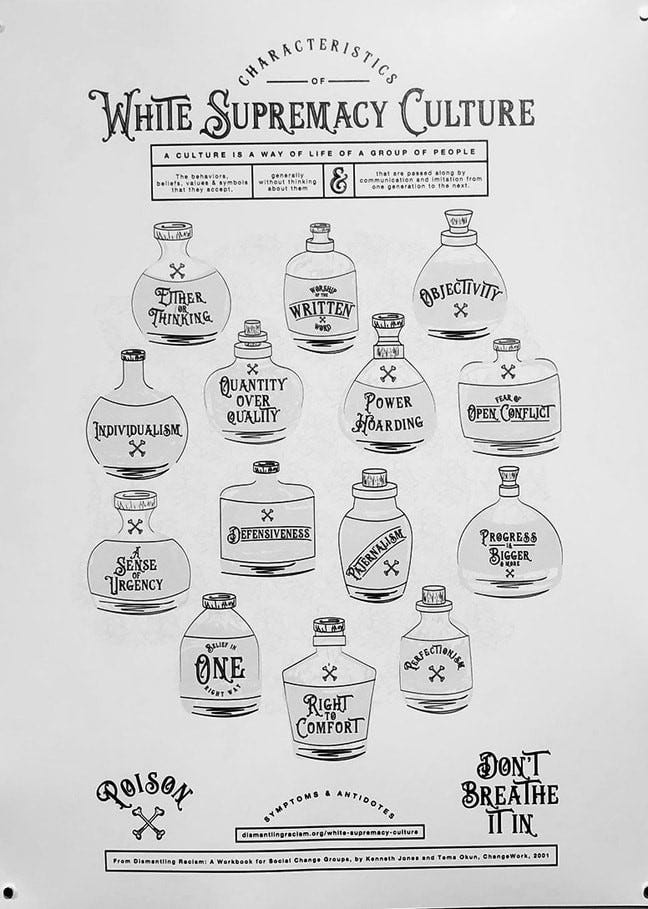Tema Okun decries the misuse of her ‘White Supremacy Culture’ list
Okun says too many have misread and misused her list
Social justice activist Tema Okun's compilation, "15 Characteristics of White Supremacy Culture," has been widely circulated within social justice circles, schools, and organizations. The list delineates perceived traits associated with white culture, including urgency, perfectionism, either/or thinking, and worship of the written word.
The below graphic makes sure that these characteristics are to be perceived as bad, depicting them as poison.
This list has been employed by activists to advocate for actions such as discarding the use of Robert’s Rules and schedules, and to accuse groups and individuals that, for example, prioritize punctuality, finishing projects on time, and keeping notes, of being 'racist' and 'upholders of white supremacy.'
.
Widespread criticism of the list
There has been much criticism of the list.
The list is unscientific, providing no evidence or references to substantiate its claims. Okun admitted that it was a spontaneous compilation penned during a moment of frustration, and her original disclaimer for the list stated, "This article was not the result of research."
The assertion that there exists a monolithic white culture is false. There is a diversity of cultures, characteristics, beliefs, and languages among whites. Racial minorities also exhibit diverse behaviors and attitudes. Many racial minorities embody traits of perfectionism, binary thinking, and individualism. Non-white cultures, such as the Chinese and Japanese, highly value the written word and punctuality.
Additionally, many of these traits are not inherently negative. While these traits can become detrimental situationally or when taken to extremes, they frequently contribute to productivity and achievement. Urgency, promptness, and focus on the written word can often yield positive outcomes.
A common accusation is that the list is not only false but blatantly racist. It reinforces stereotypes against blacks and other racial minorities. The University of Chicago evolutionary biologist Jerry Coyne wrote, “If they showed the opposite traits of those given above for black culture, it would look exceedingly racist.” He called the list “nonsense, a form of nonsense that seems not only distorted, misleading, but positively divisive. Is this kind of stuff going to heal racial divides? I doubt it.”
David L. Bernstein, of the Institute for Liberal Values, writes, “There is nothing inherently supremacist about valuing perfectionism or a sense of urgency or anything particularly egalitarian or enlightened about valuing their opposites—inattentiveness and laxity. What’s more, these are by no means ‘white cultural traits.’ Many whites have a very low sense of urgency and many non-whites a high sense of urgency, for example.”
Journalist Matt Yglesias called the list “bad” and “nonsense”, and detailed how the traits on the list have nothing to do with race and that anyone can exhibit them.
.
It turns out that Okun agrees with these detractors
In the recent lengthy interview linked below, Okun says that too many people have misinterpreted and misused her list. She says that the list was never intended to be widely disseminated online or used as a standalone. She said it was never intended to be used as a reductionist or stereotyping checklist of “whiteness” or a weapon to attack people.
The following are some quotes from the interview.
“And I just hear all kinds of stories. I’ve heard a story about a young white man here locally, who went after a black woman who was his supervisor with the list. I’ve heard about young white people going after both white bosses and people of color bosses. I’ve heard about Black, Indigenous, and people of color employees going against white bosses. So it’s been misused by lots and lots of people.“
“The way it’s misused is that people turn it into a checklist to assess or target someone and say: Look, you’re exhibiting these characteristics. And that means you’re colluding with white supremacy culture, and you’re a bad person, you’re a terrible person. Or to accuse them of being a tool of white supremacy culture.
And generally, what I find is that when people misuse it in that way, they haven’t actually read it, or they certainly haven’t read the website, because there’s no way you could read the website and come away feeling like it’s meant to be used as a checklist in that way.”
“I could not possibly tally the number of hours I have spent over the last three years dislodging people from the reductive stance they construct based on the tool … I worked in one situation where the communications function had come to a grinding halt because a segment of the staff had decided that editing was white supremacist.”
“And part of the reason for my being here today is just to say to those people who are misusing my work: Please stop. Just don’t. It’s not meant to be used to target people. That’s not what it’s meant for. It’s meant to bring people together to talk about how we’re getting in our own way and what we can do differently.“
The following are links to her interview. The first is a transcript of the interview, while the second is the audio:
Transcript: Tema Okun on Her Mythical Paper on White Supremacy





